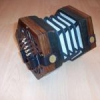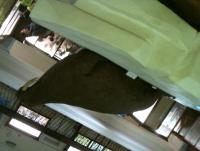-
Posts
78 -
Joined
-
Last visited
Posts posted by Spinningwoman
-
-
There's an auction on Ebay at the moment where someone is describing what looks like a Scholer Anglo as a Wheatstone Aeola, and including a Wheatstone leaflet in the pictures despite the fact that the concertina looks nothing like the one pictured in the leaflet. I am charitably assuming that the leaflet was in the box with the instrument when the seller acquired it and he assuming they went together.
-
ha, did they?
Almost. I just looked back - Why Is The English Concertina Played Sideways?
Started by Kevin L Rietmann, Feb 05 2014 09:10 AM
-
Didn't someone post this question a few weeks back?
-
There is a large modern extension to the original museum - is that what she was referring to? How far back are we talking? They did have an 'exploded' concertina in the display, so maybe they did listen to what you said - and they do have sound files available on 'interactive desks' but as far as I could see, just one for concertina-kind, though one desk was out of action. The walrus is now world famous, I think, and has become a symbol of the museum, so it's unlikely to disappear!
-
I lost my first reply but would say the same as Paul - I am very happy to have started out with a cheap Scarlatti concertina (English in my case) as I would not have been confident that I would succeed in learning to justify spending more. Also, buying a more expensive instrument is easier once you have some experience of playing. I bought my Scarlatti from Amazon but with hindsight, though Hobgoblin are a bit more expensive, I would hope they would filter out the more extreme problems some Amazon reviews report. Mine had a couple of sticky keys, but I managed to sort that OK. There is also a branch in Leeds, I believe, so you might be able to try one.
Another possibility that no-one has mentioned is that local concertina groups often have some instruments to loan out.
-
Very interesting, thanks for posting.
-
There was a reasonably detailed history as far as it went - the progression from Wheatstone through those who worked for him and then set up on their own, with a significant part of the display focused on Lachenal. And it covered both English and Anglo, though I think that little mini was misplaced. I think what I would have liked to see was a) historically some more reflection on how it developed from a posh drawing room instrument to something that everybody's grandad seems to have got their hands on and
 some hint that unlike so many of the instruments on display, these are still played and still made - I know no-one is going to be daft enough to donate a good modern instrument, but they could at least finish the story they are telling with a board about modern Wheatstone production and the other craft makers, as well as something about how the original instruments are still going strong.
some hint that unlike so many of the instruments on display, these are still played and still made - I know no-one is going to be daft enough to donate a good modern instrument, but they could at least finish the story they are telling with a board about modern Wheatstone production and the other craft makers, as well as something about how the original instruments are still going strong.I don't know what it is about concertinas. As soon as I saw one I wanted to play one. It's something about having that much sound in such a small package, and for anyone with a mechanical bent the construction is just entrancing. And the fact that I can play something that was made in 1855 not long after the actual invention, or I can buy a modern one with exactly the same fingering and layout because it has stood the test of time so well, is amazing in itself. I don't think the exhibit got any of that over, but perhaps that is asking too much.
-
I would be interested to know what your other suggestions were - I was trying to think what a more satisfactory solution would be. The sound file that comes up on their 'interactive desk' is a rather faint Rigondi recording which wouldn't inspire me to learn, I don't think. I couldn't see an Anglo sound file, though one desk was out of action so it may have been on that one.
-
Well, here I am in the Horniman cafe having peered through the gloom at about 40-50 concertinas and been unexpectedly greeted by the worlds most overstuffed walrus, which I had completely forgotten was at the Horniman! There is a little mini aeola which is labelled as an English system but looks more like an Anglo layout - am I just not looking at it from the right angle?
-
Well, here I am in the Horniman cafe having peered through the gloom at about 40-50 concertinas and been unexpectedly greeted by the worlds most overstuffed walrus, which I had completely forgotten was at the Horniman! There is a little mini aeola which is labelled as an English system but looks more like an Anglo layout - am I just not looking at it from the right angle?
-
Thanks, good to know what to expect.
-
Is the collection of concertinas at the Horniman actually on view? I thought I might go to see it next week when I'm in London, but I don't seem to be able to find details on the website.
-
One of the things I find odd about the EC is that I feel as if my left hand is the 'lead' hand despite being right handed. Possibly because many beginner tunes are in G maj, I suppose. I'm surprised not to feel any disadvantage to playing left handed notes. Maybe it's just hidden in the vast depths of my other beginner's incompetencies!
-
You missed out the information that people throw stuff at the concertina player to make him stop...
-
If it's any contribution to this very erudite discussion, when I went on holiday last year my husband refused to contemplate me playing the concertina in our hotel room so I got my daily fix playing the Englitina app on my iphone instead. I learned a new tune while we were away and could play it on my 'real' concertina when I got back.
-
I started with a cheap Scarlatti Enlish 30 key, planning to buy something better if I could get anywhere with it, having failed to master an Anglo some years before. So once I had confirmed to myself that my brain is clearly organised on the English rather than the Anglo system, I bought (or rather arranged to buy on behalf of Father Christmas) a restored 1855 Wheatstone brass reeded treble from a localish seller on Ebay, a bargain I think at £350. I've kept the Scarlatti in case I want to use it for carol singing or whatever. I expect there will be other concertinas in my future - when I get to the point of actually wanting other people to hear my playing I will probably go for a steel reeded or accordian reeded instrument, as my current one is sweet but quiet.
-
http://www.musipedia.org is good as it offers a number of different ways - the 'musical contour' works well for me as you don't need to get the key right or even be accurate with the intervals, just get the ups and downs - I had the Dorset Four Hand reel stuck in my head and had no luck with Shazam etc, but this came up with it.
-
If you don't mind quirky and homely, I love the Penn Club just off Russell Square, a few hundred yards from the British Museum. You don't have to be a member to book a room there, and the prices include breakfast. You can take your own food in and use the residents kitchen to store and heat it for other meals, which also keeps costs down. It is a Quaker institution, hence the name.
-
I'm only a beginner, having experimented very briefly with the Anglo before settling on the English, so I can't speak from long experience. But I sit next to a mirror to practice, and to me the English layout seems to have my hands in a very natural position, wrists straight, fingers in line, so that the natural curl and uncurl that fingers are designed to do brings them naturally over all the notes in a line. Compared to that, the Anglo position with heel of hand braced against a bar leading to bent wrist and the rest of the hand arched back against the strap felt much less natural to me, and possibly more likely to cause carpal tunnel problems. Would it occur to anyone who wasn't already trained to the Anglo that the English system needed turning round?
-
Searching the archives is surely one of the pleasures of arriving at a forum that has been going for years before your arrival. On any given day, there are only maybe 10-20 new posts to read, but past threads are a huge library of information and help. If you only value instant, personalised reponses from people who happen to be present on that day and happen to know something about your topic and happen not to be put off by being treated rudely when they try to help, you're losing out on most of the value.
-
Been there done that!
-
You may have inadvertently changed the options for the new content search. Look at the left hand colum - you might be searching members rather forums, for instance.
-
Well, I wasn't going to post this as I failed completely to make a recording that was even approximately free of mistakes, but then I thought it would be interesting to compare them month by month. Recording it was interesting, because I didn't realise how 'unflowing' my playing was until I heard it played back to me. I've only been playing since November, so it certainly isn't worth listening to for its musical value! Lovely tune, though.
-
So that looks like steel reeds?





Wheatstone Aeola By Scholer?
in Buy & Sell
Posted
I did message the seller to let him know that the leaflet wasn't describing the instrument he actually had - didn't get any response.